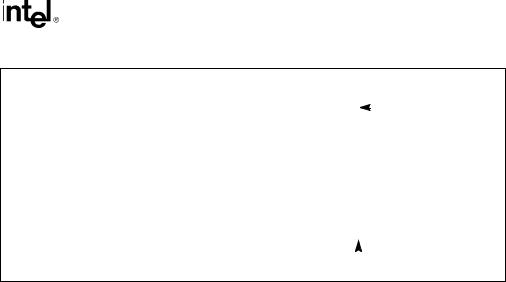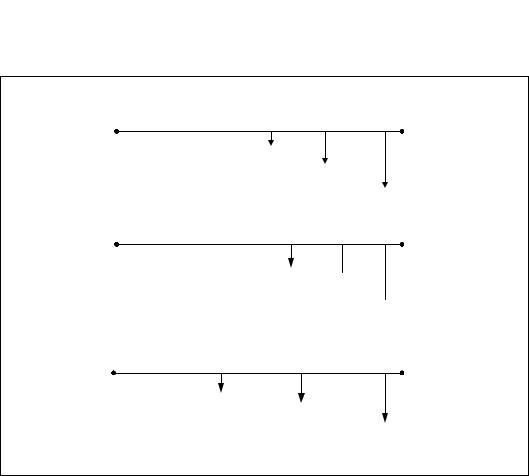
- •CONTENTS FOR VOLUME 2A AND 2B
- •1.2 Overview of Volume 2A and 2B: Instruction Set Reference
- •1.3 NOTATIONAL CONVENTIONS
- •1.3.1 Bit and Byte Order
- •1.3.2 Reserved Bits and Software Compatibility
- •1.3.3 Instruction Operands
- •1.3.4 Hexadecimal and Binary Numbers
- •1.3.5 Segmented Addressing
- •1.3.6 Exceptions
- •1.3.7 A New Syntax for CPUID, CR, and MSR Values
- •1.4 Related Literature
- •2.1.1 Instruction Prefixes
- •2.1.2 Opcodes
- •2.1.3 ModR/M and SIB Bytes
- •2.1.4 Displacement and Immediate Bytes
- •2.2.1 REX Prefixes
- •2.2.1.1 Encoding
- •2.2.1.2 More on REX Prefix Fields
- •2.2.1.3 Displacement
- •2.2.1.5 Immediates
- •2.2.2 Additional Encodings for Control and Debug Registers
- •CHAPTER 3 Instruction Set Reference, A-M
- •3.1 Interpreting the Instruction Reference Pages
- •3.1.1 Instruction Format
- •3.1.1.1 Opcode Column in the Instruction Summary Table
- •3.1.1.2 Instruction Column in the Opcode Summary Table
- •3.1.1.4 Compatibility/Legacy Mode Column in the Instruction Summary Table
- •3.1.1.5 Description Column in the Instruction Summary Table
- •3.1.1.6 Description Section
- •3.1.1.7 Operation Section
- •3.1.1.9 Flags Affected Section
- •3.1.1.10 FPU Flags Affected Section
- •3.1.1.11 Protected Mode Exceptions Section
- •3.1.1.16 Compatibility Mode Exceptions Section
- •ADDSUBPD: Packed Double-FP Add/Subtract
- •ADDSUBPS: Packed Single-FP Add/Subtract
- •FISTTP: Store Integer with Truncation
- •HADDPD: Packed Double-FP Horizontal Add
- •HADDPS: Packed Single-FP Horizontal Add
- •HSUBPD: Packed Double-FP Horizontal Subtract
- •HSUBPS: Packed Single-FP Horizontal Subtract
- •LDDQU: Load Unaligned Integer 128 Bits
- •MONITOR: Setup Monitor Address
- •MOVDDUP: Move One Double-FP and Duplicate
- •MOVSHDUP: Move Packed Single-FP High and Duplicate
- •MOVSLDUP: Move Packed Single-FP Low and Duplicate
- •MWAIT: Monitor Wait
- •INTEL SALES OFFICES

ABOUT THIS MANUAL
1.2OVERVIEW OF VOLUME 2A AND 2B: INSTRUCTION SET REFERENCE
A description of IA-32 Intel Architecture Software Developer’s Manual, Volumes 2A & 2B content follows:
Chapter 1 — About This Manual. Gives an overview of all three volumes of the IA-32 Intel Architecture Software Developer’s Manual. It also describes the notational conventions in these manuals and lists related Intel manuals and documentation of interest to programmers and hardware designers.
Chapter 2 — Instruction Format. Describes the machine-level instruction format used for all IA-32 instructions and gives the allowable encodings of prefixes, the operand-identifier byte (ModR/M byte), the addressing-mode specifier byte (SIB byte), and the displacement and immediate bytes.
Chapter 3 — Instruction Set Reference, A-M. Describes IA-32 instructions in detail, including an algorithmic description of operations, the effect on flags, the effect of operandand address-size attributes, and the exceptions that may be generated. The instructions are arranged in alphabetical order. General-purpose, x87 FPU, Intel MMX™ technology, SSE/SSE2/SSE3 extensions, and system instructions are included.
Chapter 4 — Instruction Set Reference, N-Z. This chapter continues the description of IA-32 instructions started in Chapter 3. It provides the balance of the alphabetized list of instructions and starts IA-32 Intel Architecture Software Developer’s Manual, Volume 2B.
Appendix A — Opcode Map. Gives an opcode map for the IA-32 instruction set.
Appendix B — Instruction Formats and Encodings. Gives the binary encoding of each form of each IA-32 instruction.
Appendix C — Intel® C/C++ Compiler Intrinsics and Functional Equivalents. Lists the Intel® C/C++ compiler intrinsics and their assembly code equivalents for each of the IA-32 MMX and SSE/SSE2/SSE3 instructions.
1.3NOTATIONAL CONVENTIONS
This manual uses specific notation for data-structure formats, for symbolic representation of instructions, and for hexadecimal and binary numbers. A review of this notation makes the manual easier to read.
1.3.1Bit and Byte Order
In illustrations of data structures in memory, smaller addresses appear toward the bottom of the figure; addresses increase toward the top. Bit positions are numbered from right to left. The numerical value of a set bit is equal to two raised to the power of the bit position. IA-32 processors are “little endian” machines; this means the bytes of a word are numbered starting from the least significant byte. Figure 1-1 illustrates these conventions.
1-2 Vol. 2A

ABOUT THIS MANUAL
Highest |
|
|
|
|
Data Structure |
|
|
|
|
|
|
|
|
|
31 |
24 |
23 |
16 15 |
8 |
7 |
0 |
|
|
|
Bit offset |
||||
|
|
|||||||||||||
Address |
|
|
|
|
|
|
|
|
|
28 |
|
|
|
|
|
|
|
|
|
|
|
|
|
|
|
|
|||
|
|
|
|
|
|
|
|
|
|
|
|
|
||
|
|
|
|
|
|
|
|
|
|
24 |
|
|
|
|
|
|
|
|
|
|
|
|
|
|
20 |
|
|
|
|
|
|
|
|
|
|
|
|
|
|
16 |
|
|
|
|
|
|
|
|
|
|
|
|
|
|
12 |
|
|
|
|
|
|
|
|
|
|
|
|
|
|
8 |
|
|
|
|
|
|
|
|
|
|
|
|
|
|
4 |
|
|
Lowest |
|
|
|
|
Byte 3 |
Byte 2 |
Byte 1 |
|
Byte 0 |
|
0 |
|
|
|||
|
|
|
|
|
|
|
Address |
|||||||
|
|
|
|
|
|
|
|
|
|
|
|
|
|
|
|
|
|
|
|
|
|
|
|
|
|||||
|
|
|
|
|
|
|
|
|
|
|
||||
|
|
|
|
|
|
|
|
Byte Offset |
|
|||||
Figure 1-1. Bit and Byte Order
1.3.2Reserved Bits and Software Compatibility
In many register and memory layout descriptions, certain bits are marked as reserved. When bits are marked as reserved, it is essential for compatibility with future processors that software treat these bits as having a future, though unknown, effect. The behavior of reserved bits should be regarded as not only undefined, but unpredictable. Software should follow these guidelines in dealing with reserved bits:
•Do not depend on the states of any reserved bits when testing the values of registers which contain such bits. Mask out the reserved bits before testing.
•Do not depend on the states of any reserved bits when storing to memory or to a register.
•Do not depend on the ability to retain information written into any reserved bits.
•When loading a register, always load the reserved bits with the values indicated in the documentation, if any, or reload them with values previously read from the same register.
NOTE
Avoid any software dependence upon the state of reserved bits in IA-32 registers. Depending upon the values of reserved register bits will make software dependent upon the unspecified manner in which the processor handles these bits. Programs that depend upon reserved values risk incompatibility with future processors.
Vol. 2A 1-3

ABOUT THIS MANUAL
1.3.3Instruction Operands
When instructions are represented symbolically, a subset of the IA-32 assembly language is used. In this subset, an instruction has the following format:
label: mnemonic argument1, argument2, argument3
where:
•A label is an identifier which is followed by a colon.
•A mnemonic is a reserved name for a class of instruction opcodes which have the same function.
•The operands argument1, argument2, and argument3 are optional. There may be from zero to three operands, depending on the opcode. When present, they take the form of either literals or identifiers for data items. Operand identifiers are either reserved names of registers or are assumed to be assigned to data items declared in another part of the program (which may not be shown in the example).
When two operands are present in an arithmetic or logical instruction, the right operand is the source and the left operand is the destination.
For example:
LOADREG: MOV EAX, SUBTOTAL
In this example, LOADREG is a label, MOV is the mnemonic identifier of an opcode, EAX is the destination operand, and SUBTOTAL is the source operand. Some assembly languages put the source and destination in reverse order.
1.3.4Hexadecimal and Binary Numbers
Base 16 (hexadecimal) numbers are represented by a string of hexadecimal digits followed by the character H (for example, F82EH). A hexadecimal digit is a character from the following set: 0, 1, 2, 3, 4, 5, 6, 7, 8, 9, A, B, C, D, E, and F.
Base 2 (binary) numbers are represented by a string of 1s and 0s, sometimes followed by the character B (for example, 1010B). The “B” designation is only used in situations where confusion as to the type of number might arise.
1.3.5Segmented Addressing
The processor uses byte addressing. This means memory is organized and accessed as a sequence of bytes. Whether one or more bytes are being accessed, a byte address is used to locate the byte or bytes in memory. The range of memory that can be addressed is called an address space.
The processor also supports segmented addressing. This is a form of addressing where a program may have many independent address spaces, called segments. For example, a program can keep its code (instructions) and stack in separate segments. Code addresses would always
1-4 Vol. 2A

ABOUT THIS MANUAL
refer to the code space, and stack addresses would always refer to the stack space. The following notation is used to specify a byte address within a segment:
Segment-register:Byte-address
For example, the following segment address identifies the byte at address FF79H in the segment pointed by the DS register:
DS:FF79H
The following segment address identifies an instruction address in the code segment. The CS register points to the code segment and the EIP register contains the address of the instruction.
CS:EIP
1.3.6Exceptions
An exception is an event that typically occurs when an instruction causes an error. For example, an attempt to divide by zero generates an exception. However, some exceptions, such as breakpoints, occur under other conditions. Some types of exceptions may provide error codes. An error code reports additional information about the error. An example of the notation used to show an exception and error code is shown below.
#PF(fault code)
This example refers to a page-fault exception under conditions where an error code naming a type of fault is reported. Under some conditions, exceptions which produce error codes may not be able to report an accurate code. In this case, the error code is zero, as shown below for a general-protection exception.
#GP(0)
1.3.7A New Syntax for CPUID, CR, and MSR Values
Obtain feature flags, status, and system information by using the CPUID instruction, by checking control register bits, and by reading model-specific registers. We are moving toward a new syntax to represent this information. See Figure 1-2.
Vol. 2A 1-5

ABOUT THIS MANUAL
CPUID Input and Output
CPUID.01H:ECX.SSE [bit 25] = 1
Input value for EAX register
Output register and feature flag or field name with bit position(s)
Value (or range) of output
Control Register Values
CR4.OSFXSR[bit 9] = 1
Example CR name  Feature flag or field name
Feature flag or field name
with bit position(s)  Value (or range) of output
Value (or range) of output
Model-Specific Register Values
IA32_MISC_ENABLES.ENABLEFOPCODE[bit 2] = 1
Example MSR name
Feature flag or field name with bit position(s)
Value (or range) of output
OM17732
Figure 1-2. Syntax for CPUID, CR, and MSR Data Presentation
1-6 Vol. 2A
